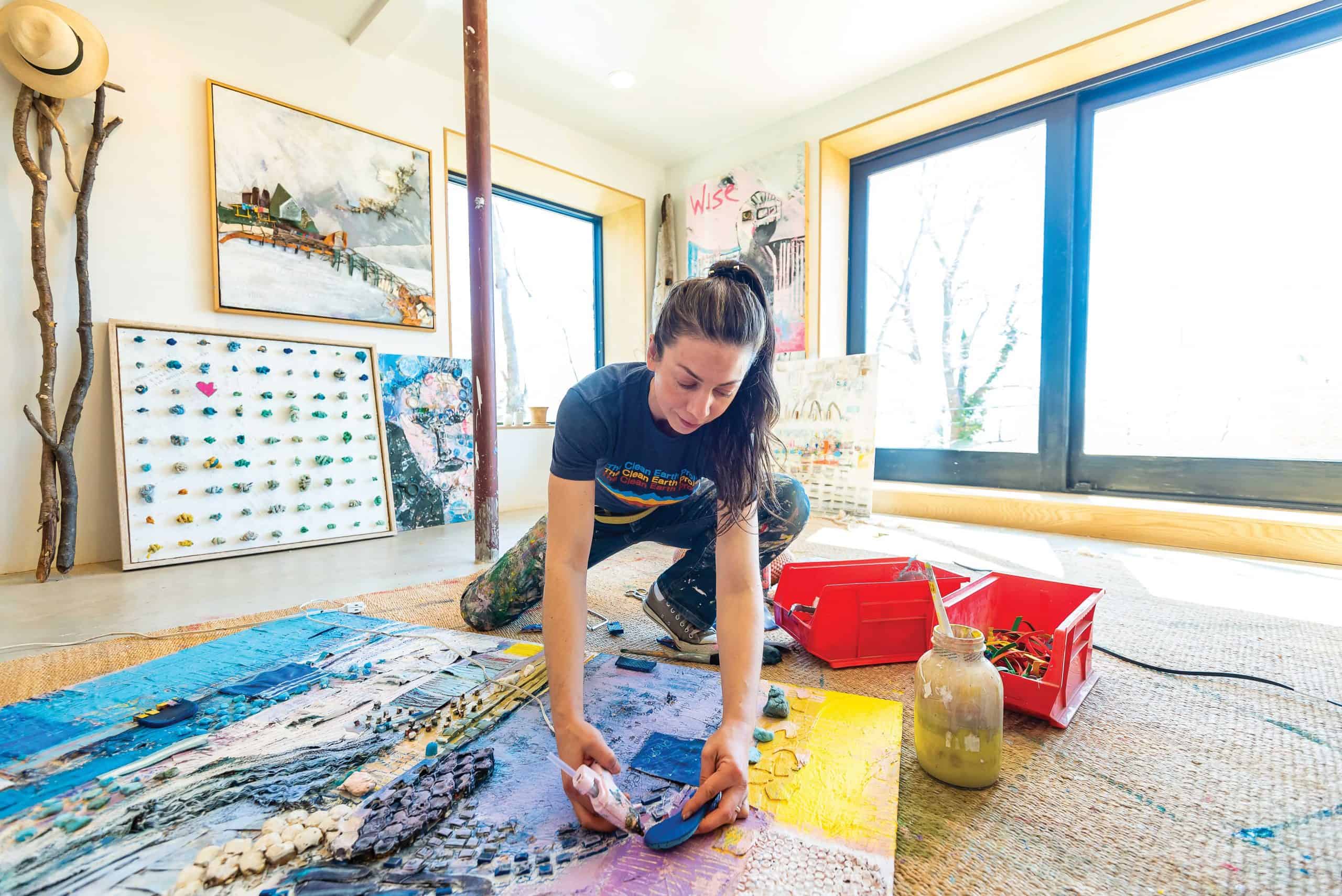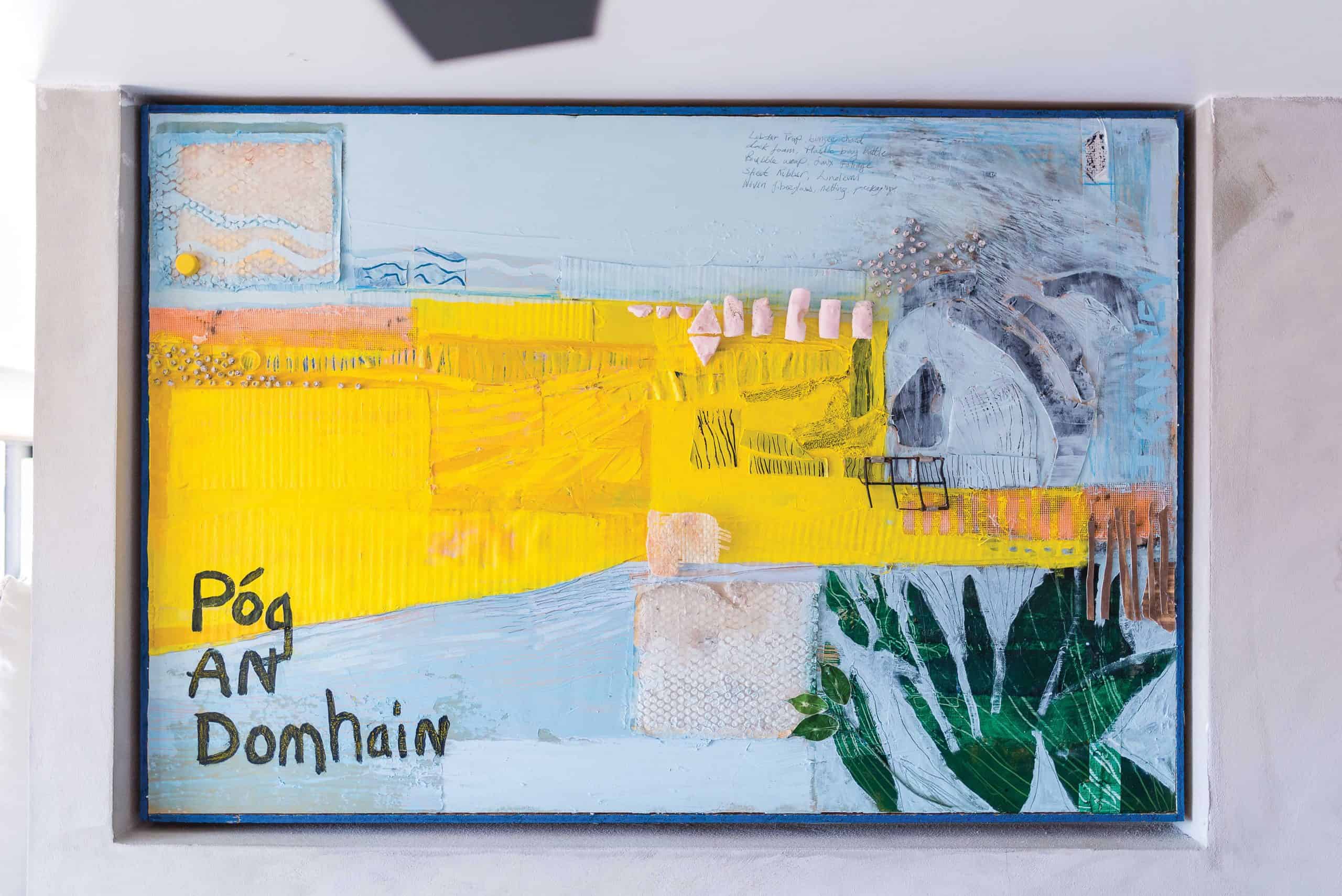A Hull artist finds inspiration and purpose in beach cleanups.
Written by Jennifer H. McInerney Photography by Kjeld Mahoney
Gazing out the windows of her contemporary hillside home in Hull, artist and activist Jackie Ranney can’t help but be moved by the brilliant expanse of blue stretching infinitely toward the horizon. In this, she’s not unique: for centuries, artists have drawn inspiration from the dazzling beauty of the South Shore’s coastal landscapes. But for Ranney, the impetus for her work also comes from beneath the ocean’s surface—where the unseen but nevertheless harmful force of pollution threatens the elaborate and delicate ecosystem.
Ranney knows first-hand that the pristine-looking Atlantic churns with untold litter and debris, which eventually wash ashore or continue to float freely, disrupting the marine life inhabiting the ocean’s depths.
Last fall, Ranney was inspired to combine her artistic pursuits with another lifelong passion: cleaning up beaches. Nearly every day, she ventures to the nearby rocky shoreline with large trash bags to collect litter. Whenever possible, she incorporates this trash into her artwork—mixing these found items with plaster, wall paint, cement and other leftover construction materials.
After each beachcombing trip, Ranney dumps overflowing bags out onto the floor of her home studio to sort through the items. She has amassed an astounding collection of castoffs—from sections of rope and fragments of battered lobster traps to flip-flops and bottle caps.


“From the start, working with these materials felt right,” says Ranney, who has completed several large-scale mixed-media compositions that illustrate the need for diligence in the protection and preservation of the ocean and its resources. She calls her collection TART: Trash Art by Jackie Ranney.
In one 4-by-4-foot painting, titled “Land and Sea,” Ranney portrays the ebb and flow of coastal life through a compilation of day-to-day detritus, including: fishing rope, bungee cord, bits of plastic cup, traffic cone, bubble wrap, rubber hose, Styrofoam tray, flip-flop, plastic bottle, dock foam and rosary beads. Similarly, the piece, “Cap it,” features an assortment of 93 discarded bottlecaps of various colors and sizes, all of which she recovered from a 10-square-foot section of Hull Bay Beach.
“My hope is that more people will start to realize how they can make a positive difference through their everyday choices,” says Ranney. “We can have an impact not only by cleaning our beaches, but in how we dispose of our trash in the first place.”
In addition to raising awareness about the prevention of ocean pollution, Ranney has made a commitment to the ongoing preservation of the ocean’s resources. A portion of the proceeds from her TART collection goes to support the Woods Hole Oceanographic Institution in Falmouth, a nonprofit organization dedicated to ocean research, exploration and education.
“Public awareness is so important for driving change,” she says. “The ocean gives us so much; we need to take care of and nurture the ocean.”



Taking On a Life of Its Own
Unlike her previous artwork, which took the form of landscapes and wildlife paintings, Ranney’s new collection allows for spontaneity in her artistic process. While she pursued a more planned approach to her traditional paintings, her mixed-media pieces are less predictable and more “reactive,” she explains.
“When I begin, I don’t have a set image in my mind of what I’m going to create—I let the materials dictate the outcome, which means that I’m fully engaged in the creative process the entire time,” says Ranney. The creation of “Prickly” took shape after a cleanup excursion to Hull Gut following the season’s most violent Nor’easter. The painting’s centerpiece, a shard of pale green weathered plastic, called to mind the abundant cacti of San Antonio, where Ranney lived before moving to Hull in 2017. Other beach debris incorporated into “Prickly” includes: lobster trap remnants, lobster trap tags, buoy, flip-flop, beach ball, fishing rope, fishing net, treated plywood, bait bag, and boat seat upholstery and foam.
“Even trash has a beauty to it, especially because I’m always looking at it through an artist’s eye,” says Ranney. “Once it ceases to be pollution, there’s an aesthetic value to it from being softened, frayed and shaped by the ocean.”



Purpose Through the Process
For Ranney, transforming trash into art has been both an eye-opening and rewarding experience. “Many artists struggle with the question of ‘What’s the point?’ in reference to their art, but this collection has given me a purpose and enabled me to answer that question with satisfaction,” she says.
Merging her activism with her art gives Ranney the opportunity to express her creativity while raising awareness about the ocean’s plight. “There’s only so much one person cleaning a beach can do,” she continues. “It’s important to me to let people know there is a problem, that the ocean is in critical peril.”
About five years ago, while living in Isle of Palms, South Carolina, Ranney and her family took part in a local initiative to protect the nesting grounds of endangered sea turtles. During that time, she learned how sea turtles unwittingly ingested plastic bags, mistaking them for jellyfish. Rescuers would find turtles floating aimlessly and starving to death, unable to dive for food, due to the buoyancy created by the plastic bags in their digestive systems. Ranney then worked on the campaign to ban single-use plastic bags in her community, a measure which passed. When she moved to Hull, she was pleased to discover that a similar ban on single-use plastic bags had already been spearheaded by a group of forward-thinking Hull High School students.
On South Shore beaches, she frequently finds what are known as ghost nets, massive snarls of fishing net, ropes, buoys and other gear that has become entangled along its waterborne way. These abandoned nets pose a particular danger to marine life, including seals and turtles, who can become ensnared and die. By removing these nets from the tideline, Ranney ends their circulation in the sea—and sometimes, the contents of these ghost nets wind up on her canvas.
With her TART collection well under way, Ranney is seeking gallery representation in New England. Her work has appeared in prominent galleries worldwide, including the National Gallery of Ireland, Atelier in Charleston, South Carolina, and the Fredericksburg Gallery in Fredericksburg, Texas. For additional information, visit jackieranneygallery.com.
